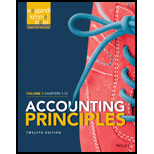
Concept explainers
(a)
Accounting for Receivables:
Receivables are defined as the amounts that are due to a firm by its customers and other parties. Receivables include all those assets that arise due to the primary operations of a firm and those representing cash that is to be collected from all external parties who owe money to the firm.
Receivables are broadly categorized into trade-receivables and non-trade receivables. Trade receivables refer to those receivables that occur due to the sale of goods and services in the normal course of business. Non-trade receivables refer to the amounts that occur due to third parties from transactions outside the primary course of business.
Bad debts can be defined as those
Bad debts are considered as expenses, as they are not anticipated to generate any financial benefits in the future. It leads to a corresponding decrease in the balance of accounts receivable on the
To prepare: The journal entries to record the transactions.
(b)
To
(c)
To prepare: The
(d)
The accounts receivable turnover for 2017 assuming the expected bad debt information provided in (c).
Want to see the full answer?
Check out a sample textbook solution
Chapter 9 Solutions
ACCOUNTING PRINCIPLES V.1 W/ WILEY PLU
- On the 5th of the month, Greg Marketing pays its field sales personnel a 3% commission on the previous month's sales. Sales for March 2016 were $1,200,000. What is the entry at the end of March to record the commissions? A. Debit Sales - 36,000$; Credit Sales Commission Expense - 36,000$ B. Debit Sales Commission Expense - 36,000$; Credit Sales Commissions Payable - 36,000$ C. Debit Sales Commission Expense - 36,000$; Credit Accounts Receivable - 36,000$ D. Debit Sales -36,000$; Credit Sales Commission Income - 36,000$arrow_forwardNet profit is calculated in which of the following account? A) Profit and loss account B) Balance sheet C) Trial balance D) Trading accountarrow_forwardThe debts which are to be repaid within a short period (a year or less) are referred to as, A) Current Liabilities B) Fixed liabilities C) Contingent liabilities D) All the abovearrow_forward
- Solution this questionarrow_forwardQuestion 2 Long term assets without any physical existence but, possessing a value are called A) Intangible assets B) Fixed assets C) Current assets D) Investmentsarrow_forwardResources owned by a company (such as cash, accounts receivable, vehicles) are reported on the balance sheet and are referred to asarrow_forward

 AccountingAccountingISBN:9781337272094Author:WARREN, Carl S., Reeve, James M., Duchac, Jonathan E.Publisher:Cengage Learning,
AccountingAccountingISBN:9781337272094Author:WARREN, Carl S., Reeve, James M., Duchac, Jonathan E.Publisher:Cengage Learning, Accounting Information SystemsAccountingISBN:9781337619202Author:Hall, James A.Publisher:Cengage Learning,
Accounting Information SystemsAccountingISBN:9781337619202Author:Hall, James A.Publisher:Cengage Learning, Horngren's Cost Accounting: A Managerial Emphasis...AccountingISBN:9780134475585Author:Srikant M. Datar, Madhav V. RajanPublisher:PEARSON
Horngren's Cost Accounting: A Managerial Emphasis...AccountingISBN:9780134475585Author:Srikant M. Datar, Madhav V. RajanPublisher:PEARSON Intermediate AccountingAccountingISBN:9781259722660Author:J. David Spiceland, Mark W. Nelson, Wayne M ThomasPublisher:McGraw-Hill Education
Intermediate AccountingAccountingISBN:9781259722660Author:J. David Spiceland, Mark W. Nelson, Wayne M ThomasPublisher:McGraw-Hill Education Financial and Managerial AccountingAccountingISBN:9781259726705Author:John J Wild, Ken W. Shaw, Barbara Chiappetta Fundamental Accounting PrinciplesPublisher:McGraw-Hill Education
Financial and Managerial AccountingAccountingISBN:9781259726705Author:John J Wild, Ken W. Shaw, Barbara Chiappetta Fundamental Accounting PrinciplesPublisher:McGraw-Hill Education





